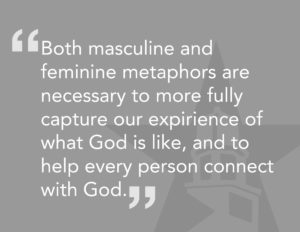As an English major with a particular penchant for poetry, I am a sucker for a good metaphor. I’ll take “silvery dimpled glass” over a simple “surface of a lake” any day. Of course I know that water isn’t really glass, but thinking about it in these terms helps me to better understand the real way that it reflects the sun and city lights with sparkling intensity. Imagine never being able to see or experience this lake scene and having to rely on metaphors to visualize it. Metaphors enliven our experiences and help us more effectively communicate those experiences to others.
 It is hard enough to wrap our minds around a lake that we have never seen – imagine what it must have been like for the Hebrews experiencing YHWH for the first time. It is no surprise that the language used to describe God in the Bible relies heavily on a rich variety of metaphors and other figurative expressions. It was not merely given the task of describing something specific in nature, but of showing something above nature, something infinite and above human understanding, in finite and understandable terms.
It is hard enough to wrap our minds around a lake that we have never seen – imagine what it must have been like for the Hebrews experiencing YHWH for the first time. It is no surprise that the language used to describe God in the Bible relies heavily on a rich variety of metaphors and other figurative expressions. It was not merely given the task of describing something specific in nature, but of showing something above nature, something infinite and above human understanding, in finite and understandable terms.
Unfortunately, for centuries the Church has predominantly relied on a select few biblical metaphors to describe God—and predominantly masculine ones, at that. We know God as Father or the Good Shepherd, a Biblically masculine role. More daring Christians use the word Abba, a more intimate word for ‘father.’ Perhaps when you picture God you imagine a wise-eyed old man with robes, flowing white hair, and a beard to match. I challenge you to think of any other way we could talk about God from the pulpit or depict God in nursery school classrooms without producing some level of discomfort or even inciting protest.
Most people don’t know that in the Bible feminine imagery is also used to describe God. Birthing imagery can be found in Job 38:8-9 and 29, Deut. 32:18, Isaiah 42:14, and Isaiah 46:3-4. Isaiah 49:15 and 66:12-13, and Hosea 11:3-4 present images of nurturing and nursing. God becomes a mother bear in Hosea 13:8. Feminine metaphors and imagery can also be found in the New Testament. In Luke 15:8-10, God is a woman looking for a lost coin, and in Luke 13:20-21 and Matt. 13:33, God is a woman working yeast into dough. Jesus becomes a mother hen gathering her chicks under her wings in Luke 13:34. Even as God incarnate in a male form, Jesus was comfortable using feminine metaphors for God and for himself.
 Ignoring these parts of scripture and limiting our understanding of God with masculine language can be incredibly damaging for two reasons. Firstly, we risk sexualizing God in a way that biblical writers tried to avoid from the beginning. The deities of surrounding societies were always either male or female and often interacted with each other in sexual ways. YHWH was clearly understood to be above their understanding of gender. By describing God with both masculine and feminine imagery, they defended the uniqueness of their monotheistic beliefs.
Ignoring these parts of scripture and limiting our understanding of God with masculine language can be incredibly damaging for two reasons. Firstly, we risk sexualizing God in a way that biblical writers tried to avoid from the beginning. The deities of surrounding societies were always either male or female and often interacted with each other in sexual ways. YHWH was clearly understood to be above their understanding of gender. By describing God with both masculine and feminine imagery, they defended the uniqueness of their monotheistic beliefs.
Secondly, limiting ourselves to masculine imagery severely limits the ways we allow people to express their experience of God. By using a variety of metaphors, the writers of scripture made God understandable to more people. For example, someone who has seen or experienced the awesome power of a mother bear and her ferocity in protecting her cubs would resonate with the image of God provided in Hosea 13:8. Whereas someone who has never seen a bear, but has experienced great hunger and thirst for much of their life, would really resonate in a unique way with Jesus’ messages about being the bread and water of life. The image of a mother bear communicates God’s power and care for the people of God, while the images of bread and water communicate God’s complete provision and ability to infinitely satisfy our needs. The same is true of metaphors and images with gendered language. God is a father, but God is also a mother who painfully, lovingly gives birth. Both masculine and feminine metaphors are necessary to more fully capture our experience of what God is like, as well as to help every person connect with God in unique ways.
As with anything described with metaphorical language, it is important to remember that God is not literally a bear, a mountain, bread, water, the foundation of a house, a woman, or a man. All of these metaphors simply help us to understand God better. However, the metaphors that we choose are very important. In a world that intentionally and unintentionally continues to privilege men, it helps to be reminded that my God can also be addressed as Mother.
Gabi is a junior majoring in intercultural studies and English.
